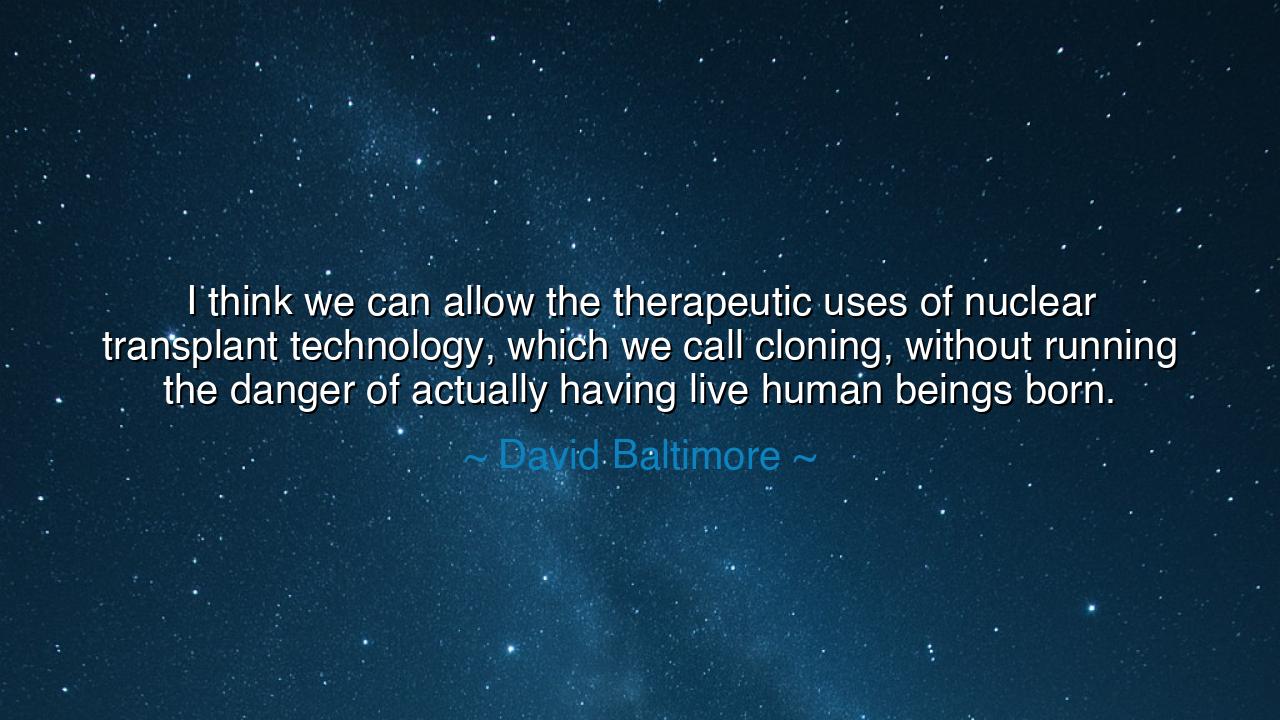
I think we can allow the therapeutic uses of nuclear transplant
I think we can allow the therapeutic uses of nuclear transplant technology, which we call cloning, without running the danger of actually having live human beings born.






David Baltimore, a sage of biology and Nobel laureate, once declared: “I think we can allow the therapeutic uses of nuclear transplant technology, which we call cloning, without running the danger of actually having live human beings born.” These words, though steeped in the language of science, carry the weight of ancient wisdom: that human beings must distinguish between what may heal and what may harm, between the gift of discovery and the temptation to overreach. He draws a line between the use of cloning as a servant of medicine and its misuse as a defiance of life’s sacred order.
The ancients spoke of fire, stolen by Prometheus, as both gift and peril. So too with technology: its flame can heal or burn, depending on the hand that wields it. Baltimore’s words echo this timeless lesson. He does not call for fear, nor for blind acceptance, but for discernment—the middle path where therapeutic uses may bring healing to the suffering without opening the dangerous gates of hubris that would attempt to manufacture human beings as though they were artifacts rather than souls.
Consider the historical example of in vitro fertilization. At its dawn, many feared it was unnatural, that it might endanger the sanctity of birth. Yet when used wisely, it brought hope to countless families who yearned for children. Its careful, ethical application transformed despair into joy. But always, its practitioners remained mindful of the boundary between healing and exploitation. Baltimore’s teaching on cloning stands in this same tradition: to use science for restoration, not domination; to treat technology as servant, not master.
We also recall the darker story of the eugenics movement of the early twentieth century, where men, drunk on the idea of genetic control, sought to manipulate life itself for power. Here lies the shadow Baltimore warns against—the danger of crossing from healing into hubris, from serving life into attempting to rule over it. History teaches us that the abuse of biological knowledge can strip away dignity and unleash horror. Thus, his call is clear: to embrace therapeutic cloning as a means of healing, but to reject the arrogance of fashioning full human beings as if they were mere experiments.
There is also a deeply moral dimension in his words. For while the mind of the scientist delights in discovery, the soul must always ask: Should we do this? Nuclear transplant technology offers astonishing potential—curing diseases, regenerating tissues, offering relief where suffering has been long. Yet its same power tempts humankind to tread into mysteries meant to remain sacred. Baltimore, with the humility of wisdom, warns that boundaries are not limitations but protections. To walk within them is not weakness but strength.
The lesson here, dear listener, is that all technology, no matter how powerful, must remain guided by conscience. As with the atom, as with fire, as with every tool humanity has ever grasped, the power itself is neutral, but its use defines its destiny. Do not shun discovery, but neither surrender to it blindly. Ask always: Does this serve life, or diminish it? Does it heal, or does it harm? For to serve life is noble, but to attempt to control its mystery is folly.
So take Baltimore’s words as both encouragement and warning. Welcome the healing gifts that science may bring—embrace the therapeutic uses of discovery with gratitude. But hold fast against the temptation to use cloning or any other tool to transgress the sacred mystery of human birth. For the measure of wisdom is not in how much we can do, but in how wisely we restrain ourselves from what we should not do. Technology must be guided by reverence, or it will lead us not to healing, but to ruin.






AAdministratorAdministrator
Welcome, honored guests. Please leave a comment, we will respond soon